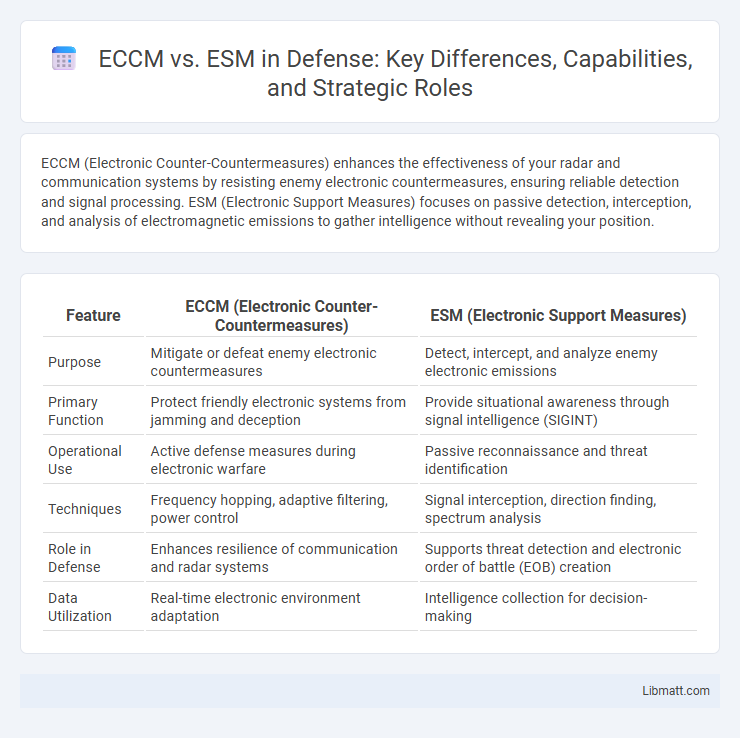ECCM (Electronic Counter-Countermeasures) enhances the effectiveness of your radar and communication systems by resisting enemy electronic countermeasures, ensuring reliable detection and signal processing. ESM (Electronic Support Measures) focuses on passive detection, interception, and analysis of electromagnetic emissions to gather intelligence without revealing your position.
Table of Comparison
| Feature | ECCM (Electronic Counter-Countermeasures) | ESM (Electronic Support Measures) |
|---|---|---|
| Purpose | Mitigate or defeat enemy electronic countermeasures | Detect, intercept, and analyze enemy electronic emissions |
| Primary Function | Protect friendly electronic systems from jamming and deception | Provide situational awareness through signal intelligence (SIGINT) |
| Operational Use | Active defense measures during electronic warfare | Passive reconnaissance and threat identification |
| Techniques | Frequency hopping, adaptive filtering, power control | Signal interception, direction finding, spectrum analysis |
| Role in Defense | Enhances resilience of communication and radar systems | Supports threat detection and electronic order of battle (EOB) creation |
| Data Utilization | Real-time electronic environment adaptation | Intelligence collection for decision-making |
Introduction to ECCM and ESM
ECCM (Electronic Counter-Countermeasures) involves techniques designed to protect radar and communication systems from electronic countermeasures, ensuring system reliability in contested environments. ESM (Electronic Support Measures) focuses on the detection, interception, and analysis of electronic signals to gather intelligence and support threat identification. Understanding ECCM and ESM is crucial for enhancing your defense strategy against electronic warfare threats.
Defining ECCM: Purpose and Functionality
ECCM (Electronic Counter-Countermeasures) enhances radar and communication system resilience by detecting, identifying, and neutralizing enemy electronic jamming attempts. Its primary purpose is to maintain the integrity and effectiveness of friendly electronic sensors and communication links in contested environments. ECCM functionalities include adaptive signal processing, frequency agility, and anti-jamming techniques to ensure continuous operational capability.
Understanding ESM: Key Features and Capabilities
Electronic Support Measures (ESM) provide advanced detection, identification, and analysis of electromagnetic emissions to enhance situational awareness in electronic warfare. ESM systems optimize signal intelligence by intercepting radar and communication signals, enabling threat recognition and electronic reconnaissance. Unlike Electronic Counter-Countermeasures (ECCM), which focus on protecting systems against jamming and interference, ESM emphasizes passive surveillance and intelligence gathering without alerting adversaries.
Historical Evolution of ECCM and ESM
ECCM (Electronic Counter-Countermeasures) evolved during the Cold War to enhance radar and communication system resilience against enemy jamming and deception tactics. ESM (Electronic Support Measures) originated earlier as a method for intercepting and analyzing electronic emissions to gather intelligence and situational awareness. Your understanding of their distinct historical development highlights ECCM's defensive role versus ESM's intelligence-gathering focus in electronic warfare.
Core Differences Between ECCM and ESM
ECCM (Electronic Counter-Countermeasures) focuses on techniques to protect radar and communication systems from enemy jamming and interference, ensuring signal integrity and operational effectiveness. ESM (Electronic Support Measures) involves the detection, interception, and analysis of electromagnetic emissions to provide situational awareness and threat identification. The core difference lies in ECCM's defensive role against electronic attacks, while ESM's role is primarily intelligence gathering and electronic reconnaissance.
Technological Advances in ECCM and ESM
Technological advances in Electronic Counter-Countermeasures (ECCM) and Electronic Support Measures (ESM) have significantly enhanced battlefield communications and threat detection capabilities. Modern ECCM systems employ adaptive filtering, frequency hopping, and advanced signal processing to protect your communications against sophisticated jamming and interception attempts. Concurrently, ESM technologies utilize wideband sensors and artificial intelligence algorithms to detect, classify, and track electronic emissions, providing superior situational awareness and threat identification.
Applications in Modern Military Operations
ECCM (Electronic Counter-Countermeasures) enhances the resilience of radar and communication systems against jamming and deception in modern military operations. ESM (Electronic Support Measures) focuses on intercepting and analyzing enemy electronic emissions to gain intelligence and early threat detection. Your forces benefit from combining ECCM's protection with ESM's reconnaissance capabilities to maintain situational awareness and electronic dominance on the battlefield.
Strengths and Limitations of ECCM and ESM
ECCM (Electronic Counter-Countermeasures) strengthens your defense by actively detecting and countering enemy electronic attacks, ensuring communication and radar systems remain operational under hostile conditions. ESM (Electronic Support Measures) excels in passive intelligence gathering by intercepting and analyzing enemy electronic emissions, providing valuable situational awareness without revealing your location. ECCM's limitation lies in its complexity and potential vulnerability to sophisticated jamming techniques, while ESM may be constrained by its passive nature, offering less immediate protection during electronic attacks.
Future Trends in Electronic Warfare Systems
Future trends in electronic warfare (EW) systems emphasize advanced Electronic Counter-Countermeasures (ECCM) that leverage artificial intelligence and machine learning to enhance threat detection and improve resilience against sophisticated Electronic Support Measures (ESM). ECCM developments focus on adaptive signal processing and dynamic spectrum management to counter increasingly agile ESM capabilities that intercept, analyze, and exploit emissions. Integration of network-centric EW architectures enables real-time data fusion, enhancing situational awareness and the effectiveness of both ECCM and ESM in multi-domain operations.
Conclusion: ECCM vs ESM in Electronic Defense
ECCM (Electronic Counter-Countermeasures) and ESM (Electronic Support Measures) serve complementary roles in electronic defense, with ECCM primarily designed to protect friendly systems from enemy jamming and interference, while ESM focuses on passive detection and intelligence gathering of adversary electronic emissions. ECCM employs techniques like frequency hopping, adaptive filtering, and signal processing enhancements to maintain communication and radar effectiveness under hostile electronic attack. ESM provides critical situational awareness by intercepting, analyzing, and classifying electronic signals, enabling strategic decision-making and enhancing the overall electronic warfare capability.
ECCM vs ESM Infographic

 libmatt.com
libmatt.com